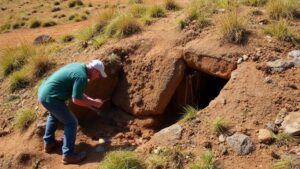Recovering Loot From Forgotten Burial Grounds and Crypts
Recovering Loot From Forgotten Burial Grounds and Crypts
The concept of recovering loot from forgotten burial grounds and crypts is steeped in historical significance, archaeology, and ethical considerations. This practice can evoke images of treasure hunters unearthing riches in remote locations or archaeologists meticulously documenting historical artifacts. But, it encompasses a multifaceted field involving legality, cultural heritage, and methods of excavation. This article aims to explore the complexities surrounding the recovery of loot from such sites, the motivation behind these endeavors, and the implications they bear on society.
The Historical Context of Burial Grounds and Crypts
Burial grounds and crypts have long served as significant cultural markers across various civilizations. Ancient Egyptians, for example, built elaborate tombs such as the pyramids, with the belief that they would accompany the deceased in the afterlife. In contrast, medieval Europe witnessed the construction of grand cathedrals that served as final resting places for notable individuals, often filled with treasures and relics.
So, understanding the historical context enriches our perspective on why such sites are of great interest to both archaeologists and treasure seekers. Artifacts recovered from these areas can provide invaluable insights into ancient cultures, rituals, and daily life. For example, the excavation of burial mounds (or tumuli) in North America has led to discoveries of grave goods such as pottery, jewelry, and tools, revealing information about the social structure and practices of pre-Columbian societies.
Legal Implications and the Ethics of Recovery
The recovery of loot from burial sites raises significant ethical and legal issues. Most countries have strict laws governing the excavation of archaeological sites. For example, the UNESCO Convention on the Means of Prohibiting and Preventing the Illicit Import, Export, and Transfer of Ownership of Cultural Property emphasizes the protection of cultural heritage.
- Legal Frameworks: In the United States, the Archaeological Resources Protection Act (ARPA) prohibits the unauthorized removal of artifacts from federal and tribal lands.
- Ethical Considerations: Archaeologists must also consider the cultural sensitivity of disturbing burial sites. Many indigenous groups oppose excavation due to the sacred nature of these areas.
The case of the Elgin Marbles serves as an example, where the British Museum has faced ongoing criticism for possessing artifacts taken from Greece without consent. This situation underscores the tension between academic inquiry and the respect for cultural heritage.
Methods and Techniques for Excavation
Recovering loot involves a range of methodologies and technologies that can ensure the preservation of the site while allowing for systematic exploration. Among these, archaeological excavation stands out as the most rigorous method.
- Stratigraphic Excavation: This technique involves digging in layers, allowing archaeologists to understand the chronological sequence of human activity. For example, when excavating a medieval crypt, stratigraphic methods helped distinguish between different periods of use and burial practices.
- Geophysical Surveys: Techniques such as ground-penetrating radar (GPR) and magnetometry can reveal the presence of buried structures or artifacts without intrusive excavation. These non-invasive methods preserve the integrity of the site and can inform excavation strategies.
Case Studies: Successes and Challenges
Several prominent case studies offer insights into both the successes and challenges of recovering loot from burial grounds. One notable example is the excavation of the tomb of Tutankhamun in 1922 by Howard Carter. This discovery sparked global interest in Egyptology and yielded incredible artifacts, including the famous golden mask. Carters meticulous methods and attention to detail provided a model for future archaeological work.
On the other hand, the search for pirate treasure, such as the infamous Atocha shipwreck, illustrates the romantic notion of treasure hunting that often oversimplifies the complexities involved. recovery of this ships loot was not only about finding gold and silver but also understanding the historical context of maritime trade and piracy in the 17th century. Also, legal battles arose concerning the distribution of recovered artifacts and the rights of salvage operators versus their historical significance.
Real-World Applications and Actionable Takeaways
Understanding the recovery of loot from burial grounds is not just academically enriching; it has several practical applications that can benefit contemporary society.
- Heritage Tourism: Well-documented archaeological sites can foster tourism, benefiting local economies while promoting cultural awareness and education.
- Public Responsibility: Citizens are encouraged to support and advocate for the protection of archaeological sites and respect for indigenous cultures, uplifting efforts that promote preservation over exploitation.
Also, aspiring archaeologists and treasure hunters should prioritize education, engage with local communities, and abide by legal frameworks to ensure their activities serve to better understand and honor historical narratives rather than undermine them.
To wrap up, the practice of recovering loot from forgotten burial grounds and crypts involves a delicate balancing act between historical inquiry, legal responsibilities, and ethical considerations. By employing rigorous methodologies and promoting respectful engagement, society can ensure the preservation of our shared cultural heritage for future generations.


